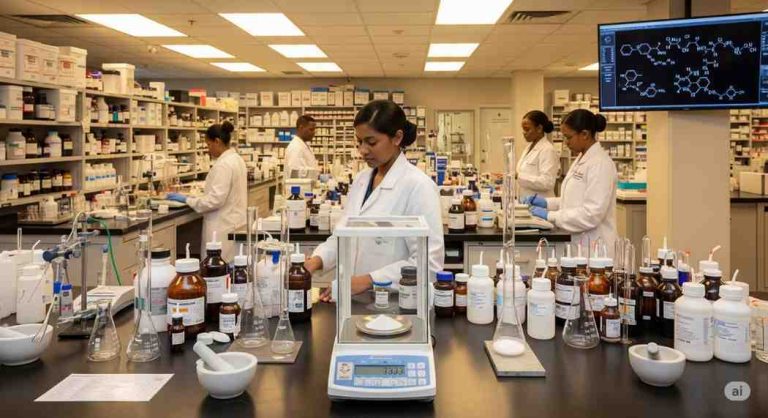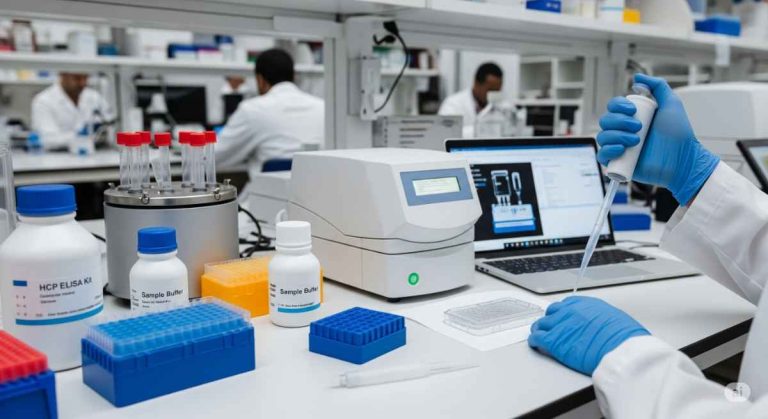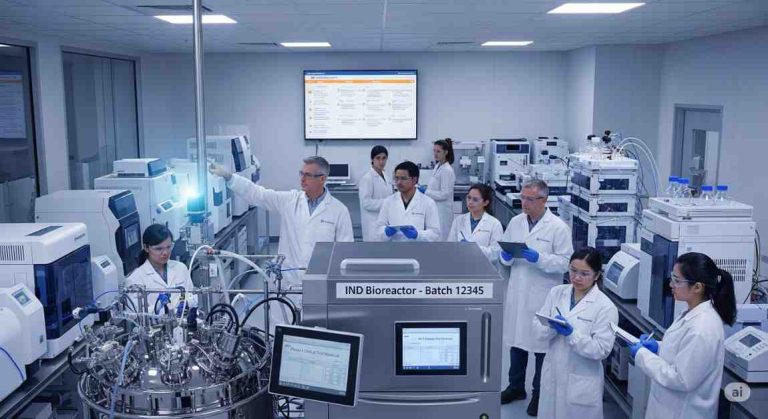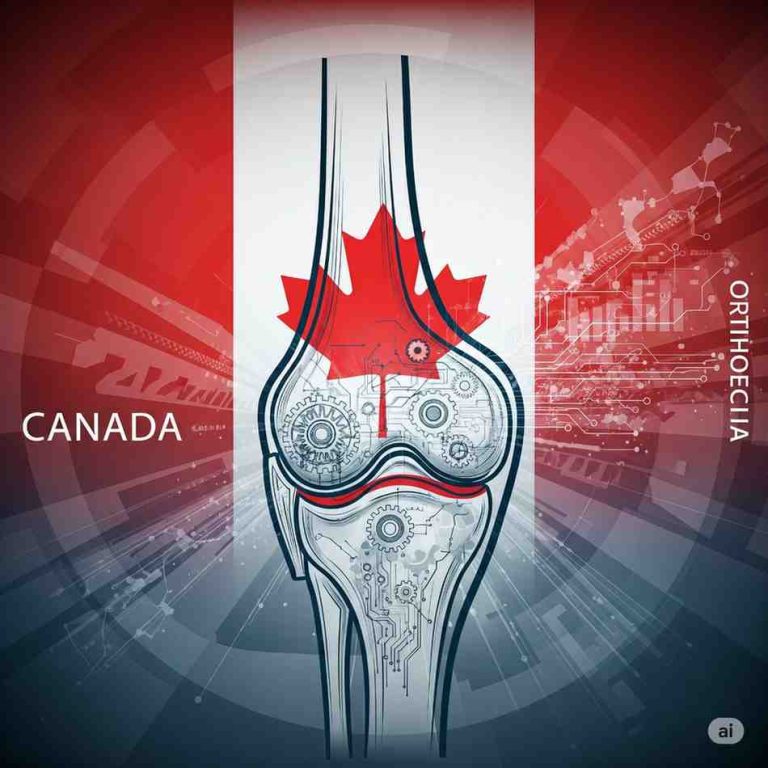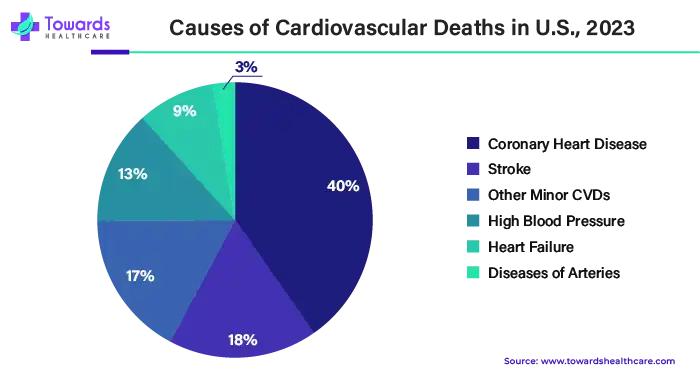
Coronary artery disease (CAD) poses a significant threat to global health, claiming millions of lives annually. It is characterized by the buildup of plaque in the coronary arteries, crucial for delivering oxygen-rich blood to the heart muscle. This plaque narrows the arteries, restricting blood flow and potentially leading to chest pain (angina), heart attacks, and heart failure. The increasing demand for coronary stents is primarily driven by the growing burden of CAD.
Table of Contents
ToggleCauses of Cardiovascular Deaths in the U.S., 2023
As the world’s population ages, the risk of CAD inevitably increases. Older individuals are more prone to developing plaque due to wear and strain on the body’s systems. This aging demographic creates a larger pool of potential patients requiring coronary stenting treatments. Modern lifestyles significantly contribute to the rise of CAD. Unhealthy diets high in saturated fat, cholesterol, and processed sugars are well-known risk factors. Additionally, lack of physical activity, smoking, and high stress levels exacerbate the condition. As these lifestyle patterns persist, CAD prevalence is expected to rise.
Diabetes is a significant risk factor for CAD. The global diabetes epidemic has substantially increased the population’s susceptibility to coronary artery issues. Diabetics undergo metabolic changes that increase plaque formation in the arteries, making them more likely to need coronary stents to restore blood flow.
Download a short version of this report @ https://www.towardshealthcare.com/personalized-scope/5152
Less Invasive and Faster Recovery Options Drive Coronary Stent Market
The coronary stent market has expanded dramatically in recent years, largely due to the growing demand for minimally invasive and rapid recovery treatment options for CAD.
Traditional therapy for clogged coronary arteries involved bypass surgery, which required a large incision in the chest cavity. While effective, this procedure has significant drawbacks, including extensive surgical trauma, long hospital stays, and prolonged recovery periods. Coronary stenting, however, offers a considerably less invasive alternative. The procedure involves inserting a catheter through a small incision in the groin or arm and guiding it to the blocked artery. Once positioned, a deflated stent is inserted and expanded, keeping the artery open and improving blood flow.
This minimally invasive approach offers several benefits for patients:
- Reduced Pain and Discomfort: Smaller incisions result in less post-operative pain and discomfort compared to bypass surgery.
- Shorter Hospital Stays: Patients often spend less time in the hospital after stenting compared to bypass surgery.
- Faster Recovery: Minimally invasive procedures enable quicker returns to everyday routines and a higher quality of life.
The less invasive nature of stenting procedures leads to speedier recovery times for patients, which is particularly important for those who cannot tolerate major surgery or wish to return to work and daily activities sooner. Faster healing also reduces overall healthcare costs associated with extended hospital stays.
The coronary stent market has greatly benefited from ongoing improvements in stent design and materials. Early stents were prone to restenosis, where the artery narrows again after surgery. Drug-eluting stents (DES) were a significant advancement, using slow-releasing medication to prevent restenosis and improve long-term patency rates. Newer developments, such as bioresorbable stents that dissolve over time, are being explored to provide further benefits.
The increasing need for minimally invasive procedures and faster recovery times, along with advancements in stent technology, are expected to drive the coronary stent market. As the global burden of CAD grows due to an aging population, unhealthy lifestyles, and rising diabetes rates, the demand for effective treatment options like coronary stenting is likely to remain high.
Moreover, ongoing research and development in stent technology suggest even more effective and patient-friendly treatments in the future. This continual innovation, coupled with the increasing demand for minimally invasive procedures, is poised to propel the coronary stent market to new heights.
Advancements Revolutionizing Coronary Stent Design
Since their inception in the late 1980s, coronary stents have undergone significant evolution, driven by the need to overcome limitations such as restenosis. The following breakthroughs have revolutionized stent design:
Drug-Eluting Stents (DES)
Bare-metal stents (BMS) were an initial improvement over bypass surgery but were prone to restenosis. DES introduced medication within stent struts, gradually released to inhibit cell proliferation and reduce restenosis risk.
Biocompatible Coatings
Early stents could cause inflammation, leading to complications. Biocompatible coatings were developed to reduce tissue irritation, promoting better healing and lowering the risk of stent thrombosis.
Stent Design and Flexibility
Early stents were inflexible, potentially leading to complications like stent malapposition. Advanced designs offer more flexibility, conforming better to vessel shapes and diameters. Closed-cell designs with laser-cut patterns enhance flexibility and ensure uniform drug delivery.
Focus on Cost-Effectiveness
Achieving cost-effectiveness involves optimizing patient care while managing healthcare spending:
- Encouraging adoption of generic stents, which offer comparable efficacy at lower cost.
- Streamlining approval processes for high-quality generic stents.
- Transitioning to value-based pricing to incentivize better long-term results.
- Negotiating bulk purchasing agreements with stent producers.
- Selecting patients judiciously for stenting treatments.
- Implementing programs to manage post-procedural care and lower readmission rates.
Investing in research and development of stents with higher efficacy and lower complication rates can lead to long-term cost savings.
To own our research study instantly, Click here @ https://www.towardshealthcare.com/price/5152
Read more about Coronary Stent Industry
You can place an order or ask any questions, please feel free to contact us at sales@towardshealthcare.com
About Us
Healthcare Web Wire is a premier subsidiary of Towards Healthcare, dedicated to providing comprehensive insights and information related to the healthcare industry. With a commitment to delivering accurate and timely updates, Healthcare Web Wire serves as a vital resource for professionals, enthusiasts, and stakeholders within the healthcare sector. Our platform serves as a central hub for the latest news, trends and developments shaping the healthcare landscape. Join us on Healthcare Web Wire and become part of a vibrant community dedicated to advancing healthcare knowledge and shaping the future of healthcare worldwide.
Explore the comprehensive statistics and insights on healthcare industry data and its associated segmentation: Get a Subscription
For Latest Update Follow Us: https://www.linkedin.com/company/towards-healthcare
About the Author
Elena Morales
Administrator
Elena Morales is a healthcare industry expert working at Healthcare Web Wire Consulting Firm, a subsidiary of Towards Healthcare. With her excellent knowledge of the field, Elena helps clients optimize their operations and navigate healthcare regulations. She's dedicated to staying updated on industry trends to make a positive impact on patient care. Elena is known for her professionalism and commitment to excellence, making her a valuable asset to any team.
